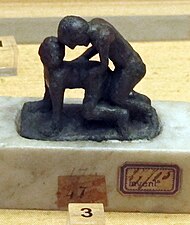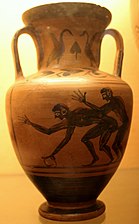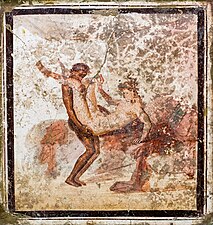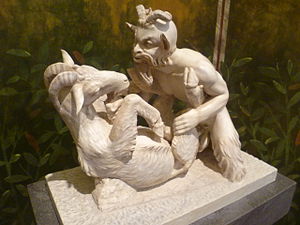Secret Museum, Naples


The Secret Museum or Secret Cabinet (Italian: Gabinetto Segreto) in Naples is the collection of 1st-century Roman erotic art found in Pompeii and Herculaneum, now held in separate galleries at the National Archaeological Museum in Naples, the former Museo Borbonico. The term "cabinet" is used in reference to the "cabinet of curiosities" - i.e. any well-presented collection of objects to admire and study.
History
[edit]Re-opened, closed, re-opened again and then closed again for nearly 100 years, the secret room was briefly made accessible again at the end of the 1960s before being finally re-opened in 2000. Since 2005 the collection has been kept in a separate room in the Naples National Archaeological Museum.
Although the excavation of Pompeii was initially an Enlightenment project, once artifacts were classified through a new method of taxonomy, those deemed obscene and unsuitable for the general public were termed pornography and in 1821[1] they were locked away in a Secret Museum. The doorway was bricked up in 1849.[2] Throughout ancient Pompeii and Herculaneum, erotic frescoes, depictions of the god Priapus, sexually explicit symbols and inscriptions, and household items such as phallic oil lamps were found. The ancient Roman understanding of sexuality viewed explicit material very differently from most present-day cultures.[a] Ideas about obscenity developed from the 18th century to the present day into a modern concept of pornography.[3]
At Pompeii, locked metal cabinets were constructed over erotic frescos, which could be shown, for an additional fee, to gentlemen but not to ladies. This peep show was still in operation at Pompeii in the 1960s.[4] The cabinet was only accessible to "people of mature age and respected morals", which in practice meant only educated men.
The catalogue of the secret museum was also a form of censorship, as engravings and descriptive texts played down the content of the room.
Gallery
[edit]- Hermaphroditus. Wall painting from Herculaneum. 1 CE – 50 CE
- Sculpture depicting sex
- Anal sex between two males. Etruscan amphora. 5th century BCE
- Marble statue of Satyr and Nymph. From Pollena Trocchia.
- Sexual scene from Pompeii in the Secret Museum
- Sexual scene from Pompeii in the Secret Museum
- Sexual scene from Pompeii in the Secret Museum
- Pan copulating with goat, 1st century BCE - 1st century CE
See also
[edit]Notes
[edit]- ^ For Roman views of sexuality, see Paul Veyne, "Pleasures and excesses" in A History of Private Life: From Pagan Rome to Byzantium, Philippe Ariès and Georges Duby, eds. (Harvard University Press) 1987: 183–207.
References
[edit]- ^ Gabinetto Segreto Archived April 11, 2011, at the Wayback Machine
- ^ Laurentino García y García, Luciana Jacobelli, Louis Barré, Museo Segreto. With a Facsimile edition of Herculanum et Pompéi. Recueil général des peintures, bronzes, mosaïques... (1877) (2001) Pompeii: Marius Edizioni On-line Bryn Mawr Classical Review
- ^ Kendrick, Walter (1987). The Secret Museum (First ed.). Berkeley and Los Angeles: University of California Press. pp. 1–9. ISBN 0-520-20729-7.
- ^ Hare & Famin 2003, Introduction.
Further reading
[edit]- Grant, Michael; Mulas, Antonia (1997). Eros in Pompeii: the Erotic Art Collection of the Museum of Naples. New York: Stewart, Tabori and Chang. (translated from the original 1975 Italian edition).
- Hare, J. B.; Famin, Stanislas Marie César (Colonel) (2003) [1836]. "Introduction". The Royal Museum at Naples, being some account of the erotic paintings, bronzes and statues contained in that famous 'cabinet secret' (translation of "Musée royal de Naples; peintures, bronzes et statues érotiques du cabinet secret, avec leur explication".







